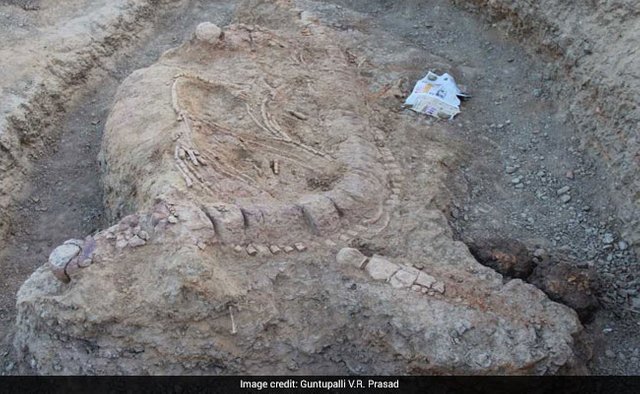
Paleontologists came across the skeleton south of Lodai village in Gujarat in 2016
Call it what you wish: fish lizard, sea monster, ichthyosaur.
After tens of millions of years, and then 1,500 hours of digging, paleontologists in India have unearthed the strikingly intact skeleton of an ichthyosaur, a marine reptile more than five meters (about 16 feet) long that resembled modern dolphins and whales.
The truly rare find could redefine paleontologists' understanding of how the creatures spread throughout ancient oceans, as the skeleton is the first from the Jurassic era to be found in India. Such fossils are more familiar farther north, paleontologists say, making the Indian skeleton a scientific marvel both for its level of preservation and surprising final resting place.
"Vertebrate fossils are rare from the Kachchh region, and we were expecting only bone fragments from this area," said Guntupalli V.R. Prasad - one of the researchers behind the study - in an interview with PLOS research news, which is affiliated with the journal PLOS ONE. "So to find a near-complete skeleton is surprising as well as exciting."
Details of the discovery were published last week in PLOS ONE.
In the interview, Prasad said that ichthyosaurs, or "fish lizards" lived between 250 and 90 million years ago. Native to oceans with warm and humid climates, the ichthyosaurs dominated the seas alongside sharks and another group of marine reptiles around the time Pangaea - Earth's single supercontinent - was breaking apart.
Indian paleontologists came across the skeleton south of the village of Lodai, located in India's western Gujarat province, in 2016, National Geographic reported. The bones were encased in dense, sedimentary rock and posed a brutal test for excavators working in a region where temperatures hit nearly 100 degrees Fahrenheit.
Those excavators were also tasked with maintaining the miraculous preservation of the skeleton. National Geographic reported that the sea monster's backbone was discovered more or less in a continuous line. Its left forefin had also maintained its true shape.
Prasad said that based on the patterns in the ichthyosaur's teeth, the sea monster was a "top-tier predator that fed on hard and abrasive food material," like mollusks, fish and even other marine reptiles. Initially, Prasad and his team couldn't find any fragments of skull or jaw that had also been preserved. But after digging below the sea monster's front part, the paleontologists came across part of the jaw vertically embedded inside the rocks.
"This was an especially useful discovery because the teeth we found offered insights into the ichthyosaur's diet," Prasad said.
Prasad told National Geographic that he hadn't conducted much research on vertebrate fossils of the region, as the number of such finds there were "very few." Not only is this skeleton the most complete ichthyosaur ever unearthed in India, but it is also the oldest - by far. Previous finds tended to be about 50 million years younger and made up of only isolated teeth or poorly preserved vertebrae, Prasad said.
Researchers also learned that the Indian ichthyosaur shares close relation with similar reptiles discovered farther north. The connection may suggest that a massive seaway once crossed the ancient continent of Gondwanaland, National Geographic reported. The seaway would have cut through land now covering India, Madagascar and South America, helping to explain how sea monsters like the India ichthyosaur navigated through Jurassic oceans.
"This find helps to show how globally widespread ichthyosaurs were during the time of the dinosaurs," Steve Brusatte, a University of Edinburgh paleontologist who wasn't involved in the study, told National Geographic. "They seem to have lived everywhere in the oceans, all over the world, at the same time dinosaurs were thundering across land."
Prasad said his team plans to carry out "extensive" field exploration in the Kachchh region to unearth more ichthyosaur fossils and locate other marine reptiles.
"We hope that our find may lead to renewed interest in vertebrate fossil research in this region, which could bring new discoveries to light," he said
Hi! I am a robot. I just upvoted you! I found similar content that readers might be interested in:
http://infloria.com/usa/indias-oldest-fossil-of-a-jurassic-sea-monster-could-tell-us-how-they-roamed-ancient-seas/
Downvoting a post can decrease pending rewards and make it less visible. Common reasons:
Submit